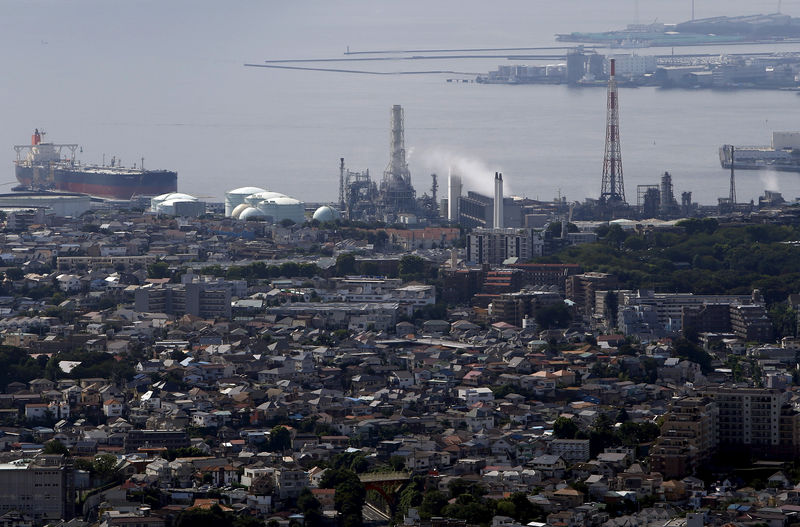 © Reuters. FILE PHOTO: A general view shows Keihin industrial zone in Yokohama
© Reuters. FILE PHOTO: A general view shows Keihin industrial zone in YokohamaBy Stanley White
TOKYO (Reuters) – Japan’s industrial output recovered only modestly in August from a recent string of natural disasters, and economists expect lackluster growth after electronics output tumbled by the most in 2 1/2 years.
Further clouding the outlook is the chance that Japan will shift more vehicle production to the United States to meet U.S. President Donald Trump’s demands to lower his country’s trade deficit and create more jobs.
Industrial output in the third quarter is likely to contract slightly, economists say. This decline should be temporary, because Japan’s domestic demand remains firm, but external risks to the outlook are growing.
“Output this quarter will not be as strong as the previous quarter because of dip in demand for electronic parts,” said Kentaro Arita, senior economist at Mizuho Research Institute.
“There is also a chance that Japan will come under pressure to shift more production to the United States if U.S.-bound exports increase.”
Trade ministry data out on Friday showed factory output rose 0.7 percent in August from the previous month, less than economists’ median estimate of a 1.5 percent rise and following 0.2 percent decline in the previous month.
Manufacturers surveyed by the trade ministry expect output to rise 2.7 percent in September and 1.7 percent in October.
Output rose in August due to a 5.2 percent increase in auto production and a 5.6 percent increase in the production of gear used to make semiconductors and flat-panel displays.
However, output of electronic parts and devices fell 8.8 percent in August, the biggest decline in 2 1/2 years. Some economists worry that the makers of these goods will cut output further because of rising inventories.
In July-September, output may fall around 0.5 percent, Mizuho Research’s Arita said, which would be a reversal from a 1.3 percent increase in the previous quarter.
This decline should be short-lived, because Japanese companies are buying a lot of equipment to deal with labour shortages, economists said.
Rising wages should also bolster domestic demand for goods, economists say.
Still, some economists are worried, because the United States is embroiled in a trade war with China, which could indirectly curb Japan’s exports of electronics and auto parts.
“We haven’t seen any impact yet from the U.S.-China dispute, but this could start to show up in October,” said Daiju Aoki, regional chief investment officer for Japan at UBS Securities.
“Japan’s demand for capex due to labour shortages is firm. The risks are coming from exports.”
Industrial output is likely to fall 0.4 percent this quarter, but then resume expansion in the following quarter, Aoki added.
The unemployment rate fell to 2.4 percent in August from 2.5 percent in the previous month, while the jobs-to-applicants ratio held steady at 1.63 jobs per applicant from, the highest level since January 1974, separate data showed.
Japan’s work force has been shrinking rapidly due to its ageing population, which is causing the jobless rate to fall.
Despite the solid economy and tight labour market, inflation is struggling to accelerate.
Tokyo’s core consumer price index (CPI), which includes oil products but excludes fresh food prices, rose 1.0 percent in the year to September, versus a 0.9 percent rise expected by economists and less than half the central bank’s 2 percent target.
The Tokyo index is available a month before nationwide core CPI, and serves as a leading indicator of consumer inflation.
Japanese retail sales rose 2.7 percent in August from a year earlier, compared with a median market forecast for a 2.1 percent increase, separate data showed on Friday.
U.S. President Donald Trump and Japanese Prime Minister Shinzo Abe agreed this week to start trade talks in an arrangement that, for now, protects Japanese automakers from further tariffs, seen as a major threat to the export-dependent economy.
Still, there are lingering concerns that Japan will have to dramatically lower auto exports to the U.S. market and greatly increase the number of cars in makes in the United States to meet Trump’s goal of creating more jobs and lowering the U.S. trade deficit.
Source: Investing.com

























